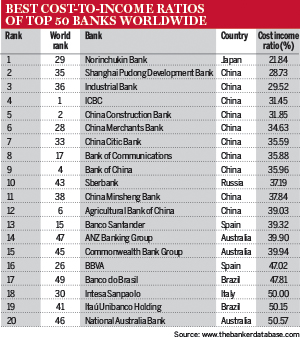Japan’s Norinchukin Bank has greatly improved its efficiency, scoring the best cost-to-income ratio of the world’s top 50 lenders. The bank’s position places a lender from a developed economy at the top of a ranking otherwise dominated by emerging market players.
The Tokyo-based lender’s 21.84% cost-to-income ratio shows phenomenal progress from the much higher, and worrisome, 64.34% ratio it displayed at the end of March 2012 – its worst in the past five years. Japanese banks’ annual reports are filed by the end of March for each year, so the ratio used for the current ranking is based on figures filed at the end of March 2015. Figures for all other banks in the ranking are taken from their end-December 2014 filings. Since its poor performance three years ago, Norinchukin has expanded its lending activity, boosting profitability – its latest return on capital is still a relatively low 8.83% – but this needs to be compared with the 1.68% profitability ratio recorded in 2012. The bank’s performance is also displayed by a better return-on-assets ratio, which rose to 0.54% from 0.1% over the same three-year period.
Following Norinchukin, the ranking of cost to income is filled by a long list of Chinese names, all the way to 12th place, with only the exception of Russia’s Sberbank in 10th position. Generally, the efficiency ratios of Chinese banks are kept low by the great earning power of the local market, which provides healthy income to local players. Shanghai Pudong Development Bank has China’s best cost-to-income ratio, at 28.73%. Despite being a development bank and so not necessarily focused on keeping down costs, the lender’s excellent ratio is indeed a reflection of improved efficiency. According to The Banker Database, in fact, returns had not greatly improved over the last financial year. The development bank’s return on assets has improved only marginally to 1.48% from the 1.46% it scored in the 2014 ranking. Similarly, the loans-to-deposits ratio rose by only 1.41 percentage points to 74.46%.
Of note is also the performance of the world’s two largest banks, Industrial and Commercial Bank of China and China Construction Bank. Despite their mammoth size, low cost-to-income ratios point towards business models that, if not nimble, can at least be described as healthy. ICBC’s 31.45% efficiency ratio is the fourth lowest among the world’s top 50 banks and is 5.18 percentage points smaller than that recorded in its 2010 financial statements. Meanwhile, China Construction Bank’s 31.85%, in fifth place in the cost-to-income ranking, is 1.77 percentage points lower than the 2010 figure.
Western Europe is represented in the ranking by Spain’s Santander and BBVA, in 13th and 16th places, respectively, and by Italy’s Intesa Sanpaolo, in 18th position.
Santander, the highest scoring among western European lenders, has drastically improved its efficiency ratio to 39.32%, 5.41 percentage points smaller than a year earlier. Similarly, western Europe’s second best lender, BBVA, displays an improved 47.02% ratio, an even more impressive 8.48 percentage points lower than its previous figure. Spain’s exposure to the profitable markets of Latin America often accounts for its banks’ good performances. However, when looking at ratios for both banks in their largest Latin American markets – Brazil for Santander and Mexico for BBVA – trends point downward or are flat when it comes to profitability. Both returns on assets and returns on capital have grown by small margins for Santander Brasil, while the same profitability ratios have dropped drastically for BBVA Bancomer in Mexico. These figures, therefore, point to the better conditions of the Spanish market, following more encouraging macroeconomic data.
Australia also features in the ranking, through ANZ Banking Group, Commonwealth Bank and National Australia Bank. While the first two lenders have improved their cost-to-income ratios over the past financial year, National Australia Bank’s spiked to 50.57% from the 41.72% it recorded in 2013 – a deterioration that seems to be largely explained by lower profitability.






